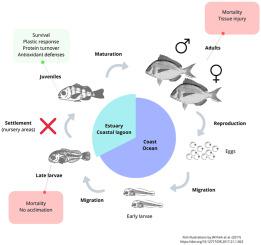Marine Environmental Research ( IF 3.0 ) Pub Date : 2020-10-13 , DOI: 10.1016/j.marenvres.2020.105192 Diana Madeira , Carolina Madeira , Pedro M. Costa , Catarina Vinagre , Hans-Otto Pörtner , Mário S. Diniz

|
Predicting responses of marine organisms to global change requires eco-physiological assessments across the complex life cycles of species. Here, we experimentally tested the vulnerability of a demersal temperate fish (Sparus aurata) to long-lasting heatwaves, on larval, juvenile and adult life-stages. Fish were exposed to simulated coastal (18 °C), estuarine (24 °C) summer temperatures, and heatwave conditions (30 °C) and their physiological responses were assessed based on cellular stress response biomarkers (heat shock protein 70 kDa, ubiquitin, antioxidant enzymes, lipid peroxidation) and phenotypic measures (histopathology, condition and mortality). Life-stage vulnerability can be ranked as larvae > adults > juveniles, based on mortality, tissue pathology and the capacity to employ cellular stress responses, reflecting the different environmental niches of each life stage. While larvae lacked acclimation capacity, which resulted in damage to tissues and elevated mortality, juveniles coped well with elevated temperature. The rapid induction of cytoprotective proteins maintained the integrity of vital organs in juveniles, suggesting adaptive phenotypic plasticity in coastal and estuarine waters. Adults displayed lower plasticity to heatwaves as they transition to deeper habitats for maturation, showing tissue damage in brain, liver and muscle. Life cycle closure of sea breams in coastal habitats will therefore be determined by larval and adult stages.
中文翻译:

鱼类生命周期对热波的不同敏感性反映了表型对环境生态位的适应
预测海洋生物对全球变化的响应需要对物种的复杂生命周期进行生态生理评估。在这里,我们通过实验测试了温带水生鱼类(Sparus aurata)到幼虫,少年和成年生命阶段的持久热浪。将鱼暴露在模拟的沿海(18°C),河口(24°C)夏季温度和热浪条件(30°C)下,并根据细胞应激反应生物标记物(热休克蛋白70 kDa,遍在蛋白,抗氧化酶,脂质过氧化)和表型指标(组织病理学,病情和死亡率)。根据死亡率,组织病理学和利用细胞应激反应的能力,生命阶段的脆弱性可分为幼虫>成年人>少年,反映了每个生命阶段的不同环境优势。幼虫缺乏适应能力,导致对组织的损害和较高的死亡率,而幼虫应对高温的能力很好。细胞保护蛋白的快速诱导维持了幼鱼重要器官的完整性,表明在沿海和河口水域具有适应性表型可塑性。成年人向更深的生境过渡以使其成熟时,对热波的可塑性较低,表明大脑,肝脏和肌肉的组织受损。因此,沿海生境的鲷鱼的生命周期关闭将由幼体阶段和成年阶段决定。











































 京公网安备 11010802027423号
京公网安备 11010802027423号